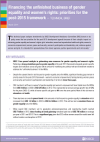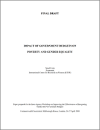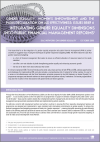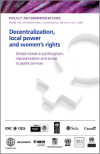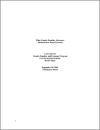FOUND 108
This note provides an overview of existing gender equality markers and reviews issues relating to the tracking and monitoring of investments related to gender equality and women’s empowerment.
This technical paper analyses investments by OECD Development Assistance Committee (DAC) donors in six policy areas that are priorities for the post-2015 development agenda because of their catalytic impact on achieving gender equality and women’s rights: girls’ education; sexual and reproductive he
The guidance note sets out commom principles and standards for gender equality markers systems that track and report on allocations and expenditures for gender equality and women's empowerment.
In this paper, Simel Esim (2000) focuses on expenditure and revenue instruments of fiscal policy as strategic entry points for engendering macroeconomics. The paper also includes a discussion of the potential implications of monetary policy and overall fiscal stance on poverty and gender equality.
This Issues Brief published by the DAC NETWORK on Gender Equality in October 2010 is on the integration of a gender equality perspective into public financial management (PFM) in partner countries. It suggests ways of using the techniques of gender-responsive budgeting (GRB).
The international Conference on Decentralization, Local Power and Women's Rights: Global Trends in Participation, Representation and Access to Public Services was held from 18-21 November 2008, in Mexico City.
This document prepared by the Working Party on Aid Effectiveness (WP-EFF) provides background information on the High Level Forum 4. It includes a description of the purpose, structure, substantive ;themes, preparation process and milestones.
Considering revenue collection and taxation as a strategy in work for women's rights and poverty alleviation is important. Different forms of taxation, and the complexities of taxation systems, frequently include a number of gender biases.
